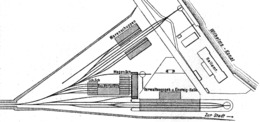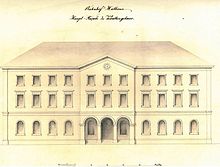Old train station (Heilbronn)
| Old train station (Heilbronn) | |
|---|---|
 Old station in Heilbronn, former track side (Dec. 2007)
|
|
| Data | |
| Design | Terminus |
| Platform tracks | 3 |
| opening | 1848 |
| Conveyance | 1874 |
| Architectural data | |
| Architectural style | classicism |
| architect | Karl Etzel |
| location | |
| City / municipality | Heilbronn |
| country | Baden-Württemberg |
| Country | Germany |
| Coordinates | 49 ° 8 '35 " N , 9 ° 12' 45" E |
| Railway stations in Baden-Württemberg | |
The old station in Heilbronn , built by Karl von Etzel in 1848/49 , is a striking classicism building in the arched style made of Heilbronn sandstone along Bahnhofstrasse , reminiscent of one of the first railway lines in Württemberg . The building is flanked by that of the Neue Hauptpost .
history
The as head station built first Heilbronner station was from 1848 terminus of Württembergischen Northern Railway . Gustav Adolf Breymann , who had temporarily taken over the planning of the northern runway for the overloaded Etzel, suggested four options for his future location in 1845:
With the first and fourth variant, the northern line could have been continued to Baden later . With the fourth, the train station would have been closer to the city, but an extension would have incurred high land acquisition costs, as the route would have had to be curved to the east around the city. The decision was made in favor of the first option, as the construction area was cheaper to purchase here and the location at the port suggested advantages for the handling of passengers and goods between rail and ship. For an unknown reason, however, Etzel did not lead the tracks in a northerly direction, but rather after a curve in an easterly direction, i.e. perpendicular to the Neckar and the outskirts. He gambled away an otherwise possible extension to the north.
The elongated, three-storey sandstone block building in the round arch style of the 1840s was built in 1848/49 according to plans by Karl Etzel. The station also had goods sheds and wagon repair shops; however, the entire railway systems were quite modest by today's standards. Two platforms , covered by a wooden “boarding hall”, extended between three station tracks, each about 150 m long, which converged on a turntable . The tracks lay roughly along the northern pavement of today's Bahnhofstrasse, the turntable roughly at today's bridgehead of the Friedrich-Ebert -brücke. At that time, the station forecourt was on the north side of the building facing away from today's Bahnhofstrasse, the facade of which is a little more structured and reveals the arcade-like former main entrance; this was originally still crowned by a triangular gable .
While the northern line went into operation on July 25, 1848, the completion of the station took another year until August 2, 1849, the waiting rooms were opened on August 16, 1849. In the meantime, the nearby Gasthof Ritter had served as a ticket sales point.
In 1854 the Heilbronn post office was built at the train station. Arriving travelers could change to Öhringen or Neuenstadt in stagecoaches on the station forecourt or travel on to Heidelberg on Neckar steamboats from the neighboring Wilhelmskanal . The timetables of carriages and boats were tailored to train traffic.
After the northern line was extended to Jagstfeld and the Kocherbahn to Hall and Crailsheim was opened, the old station could no longer handle the traffic. Therefore, in 1873, a little further west, construction began on a larger one, namely the old Heilbronn main train station , which was now designed as a through station and opened in 1874. He fell victim to the war in 1944, and today's Heilbronn main train station is in the same location .
present
The station building of the old train station burned down in the devastating air raid on December 4, 1944 . It was completely expanded again in 1948, 100 years after its construction, under a simplified roof structure. In 2004 it was restored and since then it has housed a branch of the Kolping Educational Center .
literature
- Roland Feitenhansl: "He looks wistfully with one eye at the bold winged lions" - Heilbronn station history in the light of contemporaries . In: Heilbronnica 3 . Stadtarchiv Heilbronn, Heilbronn 2006 ( Yearbook for Swabian-Franconian History. Volume 35) ( Sources and research on the history of the city of Heilbronn. Volume 17)
Web links
Individual evidence
- ^ Julius Fekete: Art and cultural monuments in the city and district of Heilbronn . 2nd Edition. Theiss, Stuttgart 2002, ISBN 3-8062-1662-2
- ↑ Joachim Hennze: How the Württemberg Northern Railway reached Heilbronn. The former junction is now in the shadow of the railway . In: Energy - New powers for Heilbronn . City Museums Heilbronn, Heilbronn 1997, ISBN 3-930811-65-0 , p. 43-50 .
- ↑ Roland Feitenhansl: Heilbronn station - its reception building from 1848, 1874 and 1958 . DGEG Medien, Hövelhof 2003, ISBN 3-937189-01-7 .
- ↑ Christhard Schrenk: Heilbronn becomes a railway junction. In: The Heilbronn Stadtbahn: Rail traffic between Eppingen and Öhringen. regional culture publisher, Ubstadt-Weiher 2005, ISBN 3-89735-416-0
- ↑ The first railway to Heilbronn 100 years ago . In: Historischer Verein Heilbronn: Jubilee publication . Historical Association, Heilbronn 1951 (Publication / Historical Association Heilbronn, 20)




